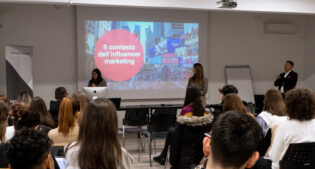10 topics to talk about to make a good impression with designers. Whether the conversation takes place on social media, in chat, live, in a group or face-to-face, knowing macro topics related to the design world can be useful. Not only when business is involved, but also when there may be a cognitive or romantic interest. Design can speak a very technical language, full of anglicisms, but don’t worry, with these topics you will be able to enter a conversation.
Before suggesting what to say during a conversation with a designer, let’s start from the beginning:
what does a designer do?
According to some definitions a designer is someone who deals with design by profession, especially in the furniture sector. In fact, design is so vast that this definition captures only one point of view. Which is also mine, as I am an interior and product designer. However, there are various types of designers, linked to the world of graphics, fashion, web, sound and so on. I will focus more on the perspective of the interior and product designer.
Let’s start with the
10 topics of small talks with designers
Design thinking
It’s a philosophy of doing, a concrete rather than a theoretical approach, which rests its foundations on analytical skills and creative attitudes to solve complex problems. Design thinking is now being talked about in several areas, not only those related to the world of design, especially in the field of management consultancy, digital transformation and software and interface design. Design thinking allows you to scrutinize the customer’s world, better defining the context of use of a product or service and experiencing all phases of the customer journey. All these processes necessarily lead to field testing, especially of products. And here the creation of prototypes becomes an inevitable step.
Prototyping
It’s the process of creating a first prototype of a product, which is used to evaluate the fine-tuning of the details and any critical issues to be changed or improved. Let’s consider it the 1.0 version of any product, often made to scale, in reduced sizes or with materials that simulate the final ones in their features. Prototyping is important because it’s a sort of first examination of a product and it’s an expensive phase during which the margins of error must be kept absolutely low.
Urban regeneration
It’s said that there will be more and more need for designers in the future. This is because the role of design is closely linked to the needs of the society. A society that obviously moves and acts within a space that is also common. All the recovery and redevelopment actions of an urban space fall within the concept of urban regeneration. Urban regeneration deals with quality and safety not only from an environmental point of view, but also from a social point of view, dedicating attention and resources to abandoned or degraded suburbs. This theme is strongly interconnected with sustainability, which we will address in the next point.
Sustainability
This is the most crucial and recurring theme of recent years, which develops in its environmental, social, economic and ethical sense. Sustainability is an act of love towards the future and the generations that will follow us. Less waste/zero waste, greater efficiency and optimization of the consumption of exhaustible and natural resources. The objective of sustainability – in a broad sense – is to improve the standard of living of people around the world, without increasing the use of resources beyond the levels sustainable by the planet.
Ergonomics
It deals with the integration between human work, machine and environment and is aimed at increasing their efficiency. Ergonomics can be physical, cognitive and organizational. The ultimate goal is to design objects or experiences that are able to benefit those who use them, avoiding physical wear and tear, mental fatigue and enhancing their performance. Ergonomic products, for example, are those that have a high degree of usability. A web designer, to cite an example, hardly ignores an ergonomic mouse.
Design week
You don’t even need to specify where, because – everyone knows – Design Week is in Milan. Generally placed in the month of April – except for the covid years, in which it was in September and June (a crazy edition with 38° in the shade) – it’s the week in which the whole universe of design meets in Milan , considered the world capital of the sector. It has two great settings. It has two great wheres. First one is in Rho, the dear old fair, where companies display catalog products and new products inside the pavilions. The second is a widespread setting, literally, throughout Milan. The design districts – Tortona, Brera, Isola, Lambrate – host companies, start-ups and experimenters of all kinds in every available location.
Those who have a showroom in Milan work to create events, during the day but above all at night. You will find prosecco and aperitifs that add up to the music and a whirlwind of novelties (and/or already seen) that invests Milan – in certain moments it paralyzes it – and makes it sparkling, lively, a center of attention. Companies and professionals, the curious and design lovers arrive from all over the world, because it is a great Carnival, in which taking inspiration is inevitable. Design Week is also suitable for design haters, there is prosecco for everyone.
Compasso d’Oro
They are a bit like the Oscars of design, let’s face it. It’s one of the most prestigious awards in the world which also includes honorable and career mentions, the Targa Giovani and the international award. Established in 1954 by Gio Ponti, it’s the oldest but above all the most authoritative world design award. To win the coveted prize, it’s necessary to register and have passed the selections of the ADI Design Index. The winners are decided by the Permanent Observatory of Design which includes critics, historians, designers and journalists and the winners can be both products and projects and services. The Tratto Pen – to name one – is a product that won the Compasso d’Oro in 1979.
Moodboard
Someone still calls it a “style board”, but it’s cooler to say moodboard, you have to admit it. They are a set of images or graphics or photos that make up a creative imagination. In practice, a concentrate of inspirations that summarizes the concept that you want to communicate. If when you were young you cut out the pictures from the newspapers and glued them on the pages of your diary, know that you were composing – even without knowing it – a sort of mood board. Often when an interior designer has to translate the client’s aesthetic requests into an environment that he/she has to design, he/she does something very similar. Create a collage of products, colors, various elements that suggest the final effect without actually showing it.
Metaverse
Of course designers are strange, they don’t have time to define the furnishings of a villa that already loom large with their thoughts on how to design the metaverse on a human scale. Put simply, this metaverse is a digital world built on the image of the real one, within which we can access through a virtual version of us (an avatar or something similar). With the help of special viewers and other wearable technologies, the experience in the metaverse becomes more and more immersive and, in some ways, adherent to reality.
By wandering around in the metaverse we will be able to buy intangible goods (a new suit to wear our avatar?) but also tangible goods that we can have delivered to our home (the real one, I mean). The most visionary subjects of the real estate market have already started investing in this world, buying “virtual land” as a form of investment. Where the land is now, tomorrow maybe a house, a villa, a condominium, a hotel will be built, who knows. The designers are already rubbing their hands together.
Social housing
It aims to improve the housing conditions of those who, for economic reasons or lack of suitable buildings, are unable to access a quality residential context. Social housing concerns a new form of living, suitable for those who, while not living in poverty, still cannot afford their own home. What it gives life to is a sort of social housing sustainability, also supported by the provision of highly energy-efficient buildings. It’s a bit of a modern and more sustainable version of what the working-class neighborhoods once were. Now they come with more services, green areas, meeting centers and cultural promotion.




1 Comment
broad topic design is everywhere because we become aware of it
it has always existed
a simple pen that we use every day had to be thought out to be drawn
and technology helps to integrate it everywhere now